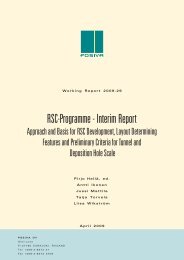A review of porosity and Diffusion in Bentonite (pdf) (2.4 MB) - Posiva
A review of porosity and Diffusion in Bentonite (pdf) (2.4 MB) - Posiva
A review of porosity and Diffusion in Bentonite (pdf) (2.4 MB) - Posiva
You also want an ePaper? Increase the reach of your titles
YUMPU automatically turns print PDFs into web optimized ePapers that Google loves.
17with <strong>in</strong>creas<strong>in</strong>g density <strong>of</strong> the bentonite. As noted by Bourg et al. (2003), the escalation<strong>of</strong> the tortuosity factor is due to the neglect <strong>of</strong> <strong>in</strong>terlayer water which becomes the major<strong>porosity</strong> type when density <strong>in</strong>creases above 1800 kg/m 3 .Other models subdivide the effective diffusion coefficient <strong>in</strong> its components associatedwith free porewater, DDL water (usually denoted as surface diffusion), <strong>and</strong> <strong>in</strong>terlayerwater (Eriksen et al. 1999; Bourg et al. 2006, 2007; Kozaki et al. 2008). The effectivediffusion coefficient becomes:D e, i = ε free D p, i + ε DDL D DDL, i + ε IL D IL, i (27)which for anions turns <strong>in</strong>to (discussed <strong>in</strong> Section 5.1): freeD e ,i free D2 w,i(28)free<strong>and</strong> for cations <strong>and</strong> neutral species:freeDDL ILD e ,i free DDL ILD 222 freeDDLILw,i(29)In these models, the concentration gradient <strong>in</strong> free porewater is used as the driv<strong>in</strong>g forcefor the diffusive flux. However, the concentration scales <strong>in</strong> the diffusion doma<strong>in</strong>s aredifferent, <strong>and</strong>, <strong>of</strong> course, the concentration gradient should be calculated <strong>in</strong> accordancewith that scale. Thus, as demonstrated <strong>in</strong> section 4.2, a fractional scale must be used forcalculat<strong>in</strong>g the concentration gradients for diffusion <strong>in</strong> <strong>in</strong>terlayer water.Van Loon et al. (2007) measured the diffusion <strong>of</strong> 36 Cl - <strong>in</strong> bentonite at various NaCl concentration<strong>and</strong> obta<strong>in</strong>ed anion-accessible porosities from the data, which are assumedhere to be equal to ε free . For a comprehensive dataset, they showed that the geometricalfactor for Cl - followed Archie’s law:1G 2 nfree(30)with n = 0.9 (Figure 7). Muur<strong>in</strong>en (1994) found a similar relation, but with n = 0.6. Thel<strong>in</strong>e given by Archie’s law <strong>in</strong> Figure 7 was forced to pass through the free water value,D w , Cl = 2.03×10 -9 m 2 /s. It can be seen that this forc<strong>in</strong>g leads to a slight overestimate <strong>of</strong>the effective diffusion coefficient compared with experimental values <strong>and</strong> it may be thatthe real tortuosity is somewhat larger.
















